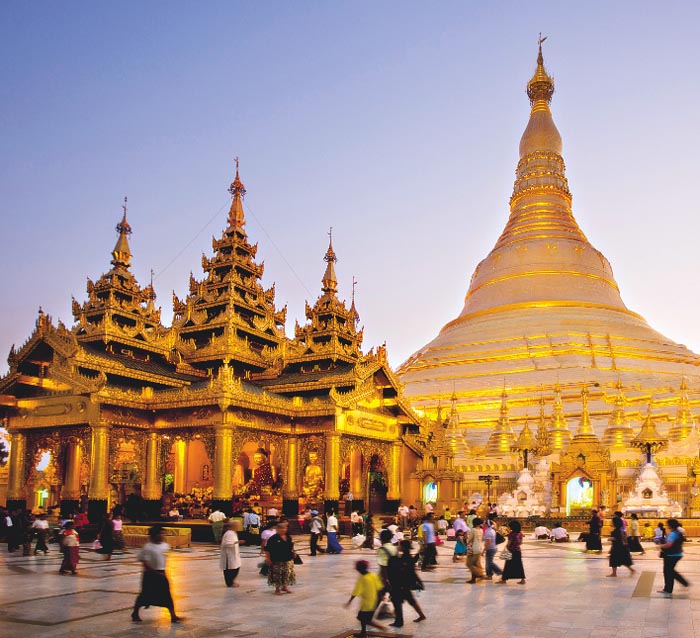Myanmar, one of Asia’s last great frontiers, is opening up rapidly – which means that now is the time to go

The placid, silver waters of the Irrawaddy River are broken only by a rare dolphin or the occasional longboat that chugs by; flat lands stretch out dense and green as far as the eye can see, the odd rustic settlement or shimmering golden pagoda popping up amid the foliage along the banks of the river.
“This is Burma and it will be quite unlike any land you know about,” wrote Rudyard Kipling after he travelled here in 1889 – and his words still ring true today. Little has changed in the landscape of the country, now known as Myanmar, since the days of his journeys on this river and its tributaries, which span 2,000km from their source high in the Himalayas and cut through a complex and culturally diverse country, all the way down to the Andaman Sea.
While some opponents of Myanmar’s ruling military regime have called for a boycott of tourism since the mid-1990s, its appeal as a mysterious, golden land has long intrigued travellers. And here I am aboard a luxury river liner, The Road to Mandalay, operated by travel company Orient-Express.
Ravaged by British colonial rule from the mid-19th century and then invaded by the Japanese in 1942, the country became a battleground during World War II between Allied and Japanese troops. It finally gained independence in 1948 and, for most of the time since, has been under the thumb of one of the world’s most notorious military dictatorships.

Reports of genocide, slave labour and severe oppression have trickled out ever since, despite the military’s attempts to control the flow of information. The country hit international headlines again in 2008 when Cyclone Nargis devastated many areas: at least 138,000 people were killed and countless more left homeless.
Since 2011, when a new quasi-civilian government was sworn in, Aung San Suu Kyi and her political party – the National League for Democracy (NLD) – have welcomed responsible tourism. And tourists are certainly made to feel welcome here: as I step off the plane in Yangon, men in longyis, the traditional Burmese sarong, and women with cheeks painted with thanaka (a yellow paste made from ground wood and used as a sunscreen) greet me with the warmest smiles – reminding me that the people are everything the regime is not.
Yangon is a crumbling town like no other. The golden Shwedagon Pagoda, a sacred Buddhist shrine, towers over the city, a beacon of hope and beauty in a troubled land. Downtown, springing from cracked pavements, worn colonial structures hark back to a bygone era and stand alongside ageing tenements, booksellers and open-air markets. There are few bars; men sit out in the street on plastic stools and watch football on television. In stark contrast, in the north of the city, picturesque wooden mansions are dotted around Inya Lake, close to Suu Kyi’s home, where she was kept prisoner for nearly 15 years.

Democracy is no longer a distant dream but a realistic aspiration, and with sanctions being lifted by the US and other nations, companies are vying to take advantage of these 60 million people and their resource-rich land, full of rubies, gas and oil. Over cocktails in The Strand Yangon – a gorgeously restored colonial building – I encounter a fellow Irish wanderer, an employee of a big telecoms company, who is in town investigating how it can expand its business into the country. Change is most certainly afoot.
This gradual shift in Myanmar society means hotels that once struggled are now booked up months in advance, and prior planning is advised; travel here is still relatively expensive, very different from the well-trodden backpacker path elsewhere in South-East Asia.
But part of the magic of Myanmar is that it remains close to the past: mobile phones can cost as much as US$200 in a place where the average wage is US$3 a day; the first ATM for local bank card holders was opened in 2012; your phone will not roam here; and credit cards are only accepted at a handful of big hotels.
To the north, in another former capital, Mandalay, the feeling of change is different again. The city is closer to the border with Yunnan, and mainland Chinese investors have bought up swaths of land. Their presence is in evidence throughout the town, in the modern McMansions and upmarket shopping malls that have sprung up, very much in contrast to the peasant lifestyle of most of the area’s inhabitants.

Next, we visit monasteries and nunneries in the city of Sagaing where saffron-robed monks patiently queue for their daily meal while shy, smiling, shaven-headed nuns chant their lessons in a chorus of rhythms and rhymes. Nearby in Amarapura, we cross the rickety, 1.2km U Bein Bridge, the world’s longest teak bridge, which spans the lake. Climbing into blue longboats at the water’s edge, we float by the bridge and watch as the sun sets in myriad colours.
The next morning another short flight takes us back to Yangon, and it is here my magical journey ends – for now. I can only wonder what this country will be like when I return.
